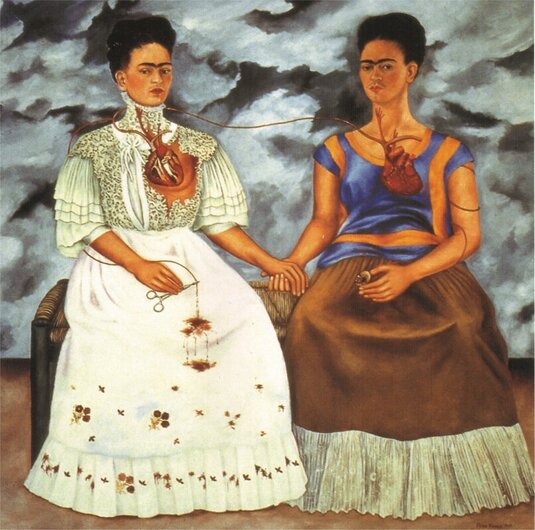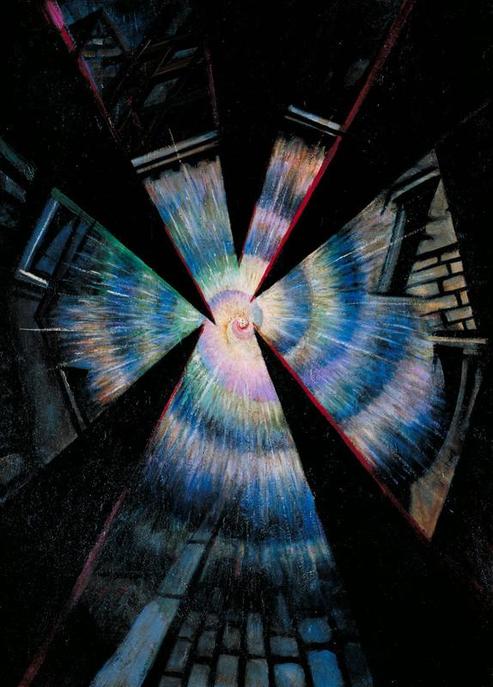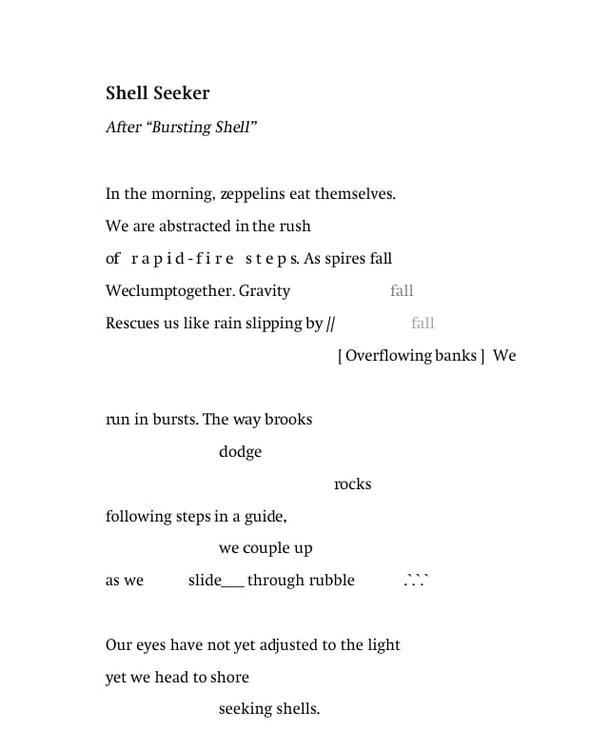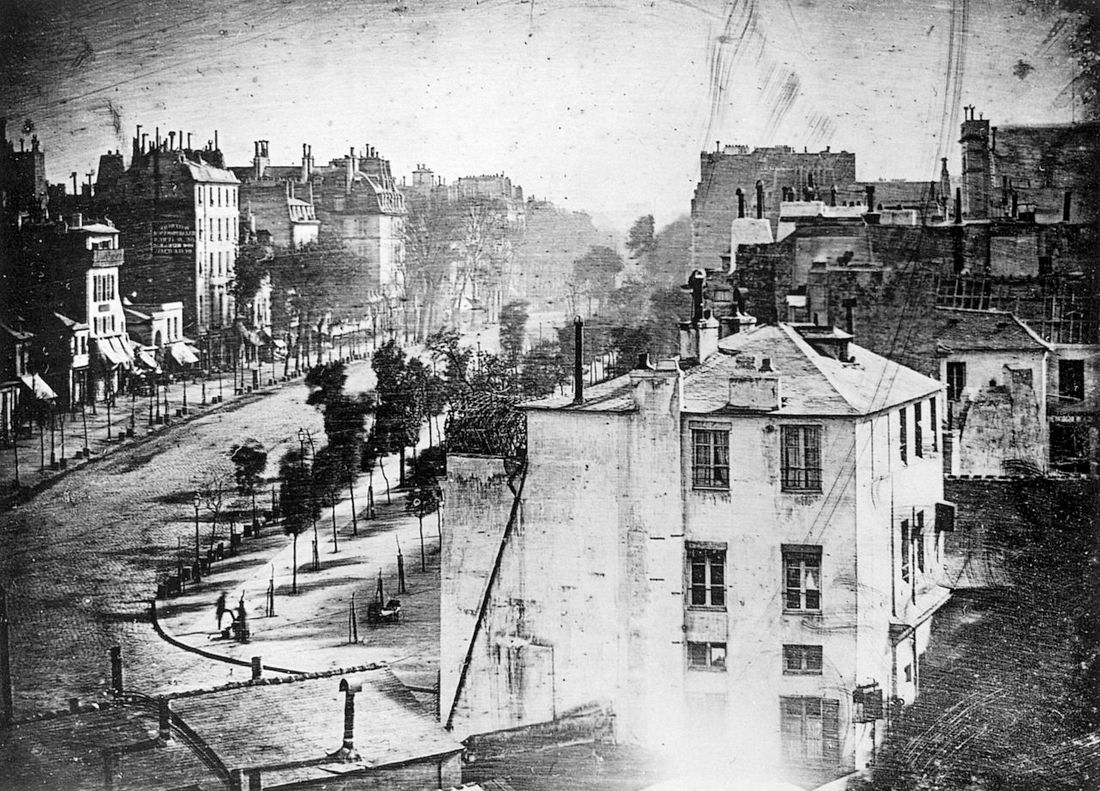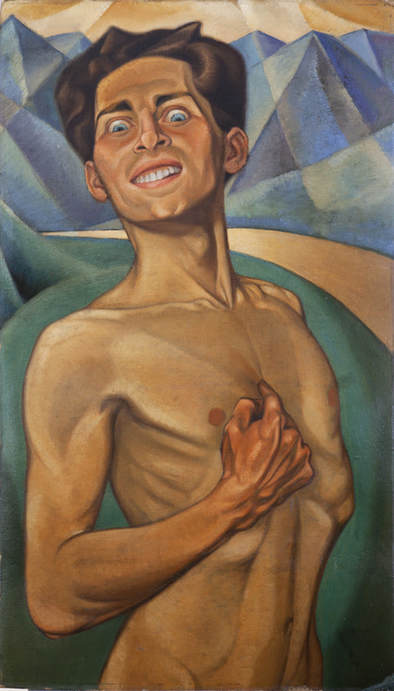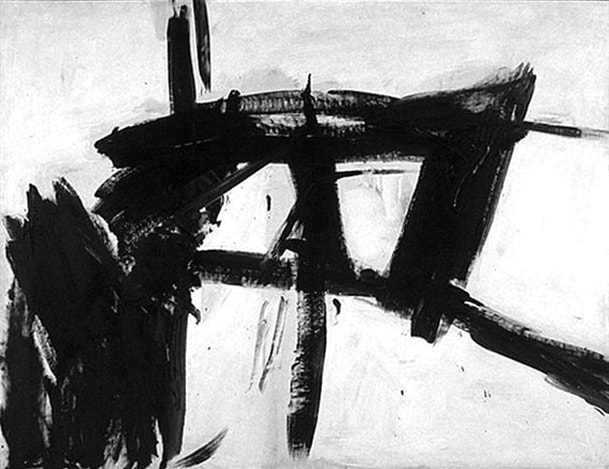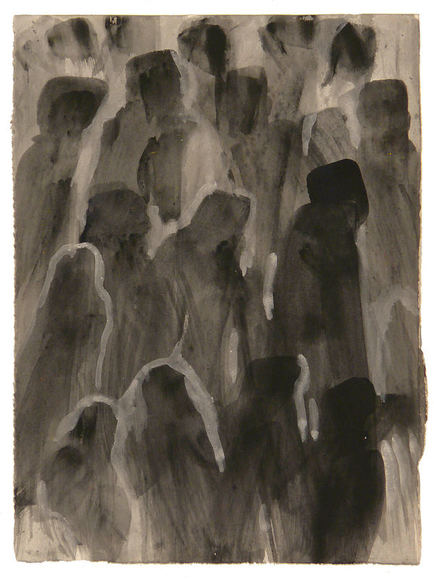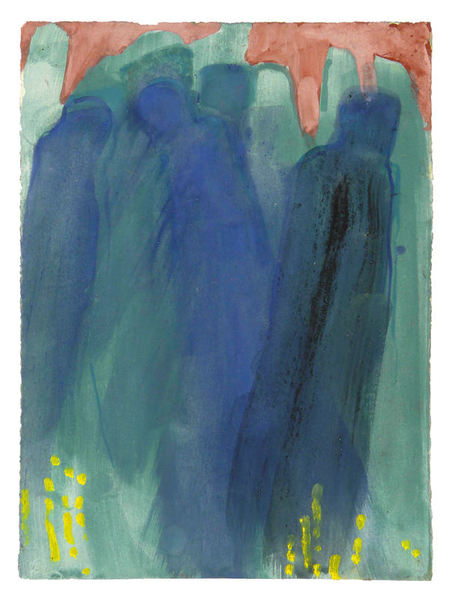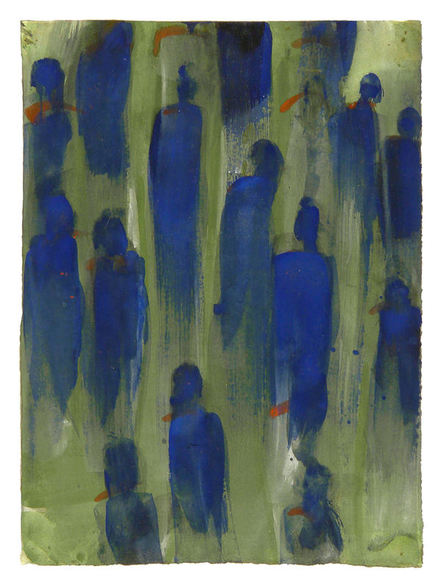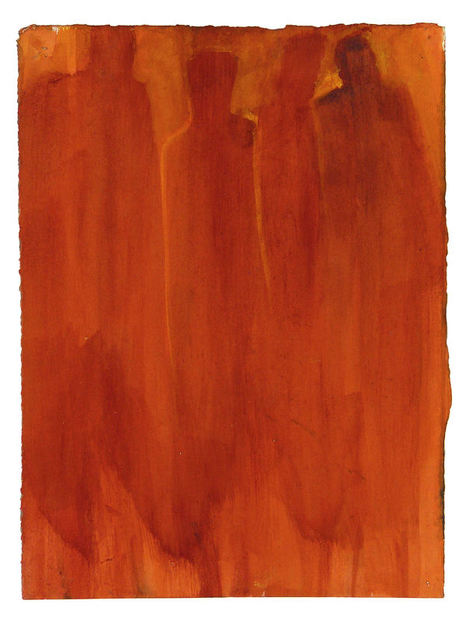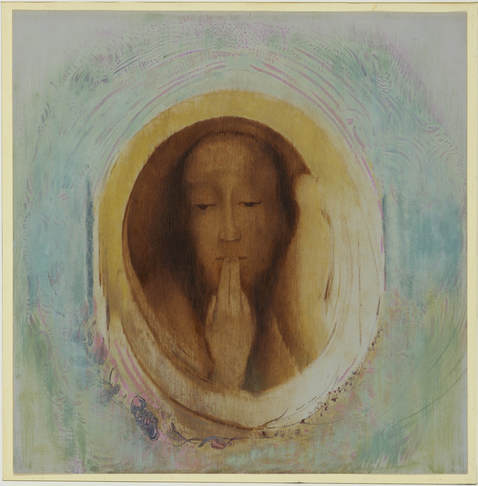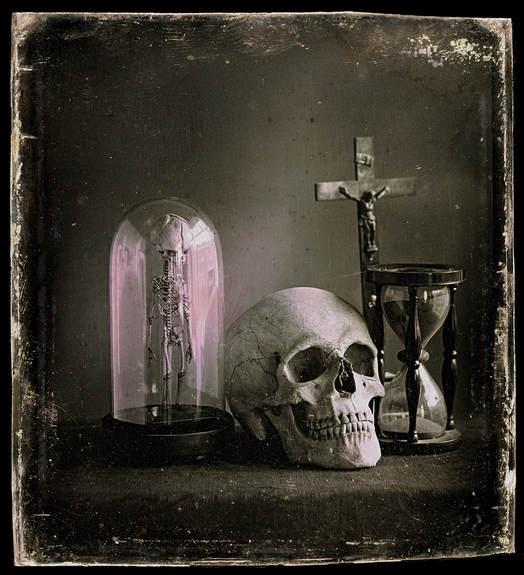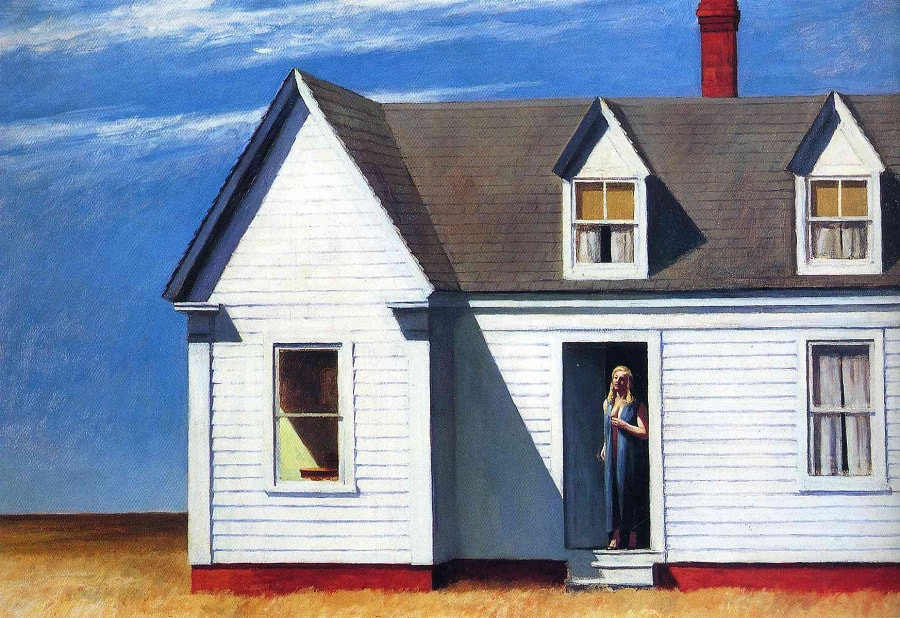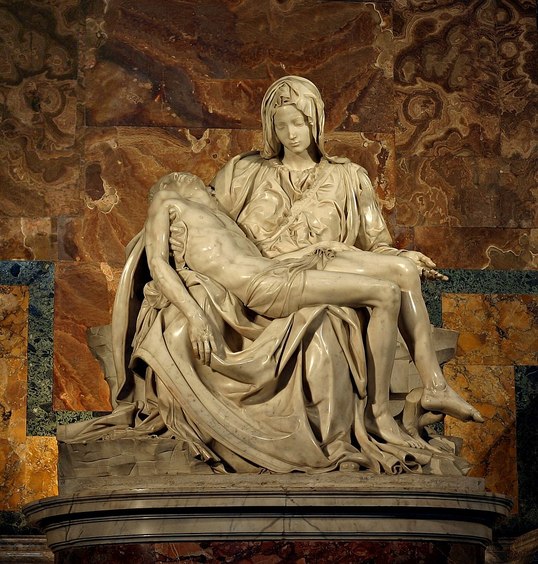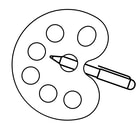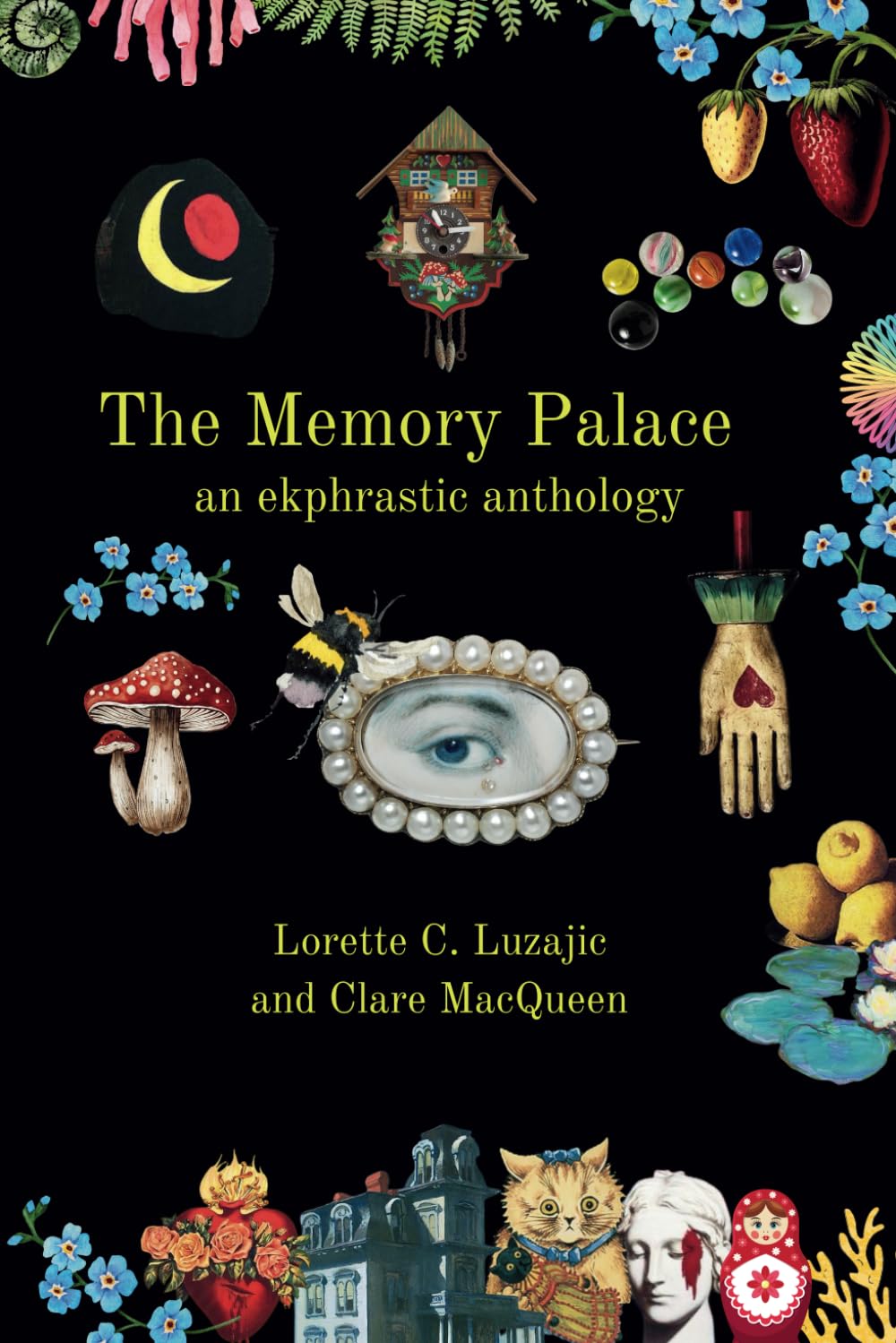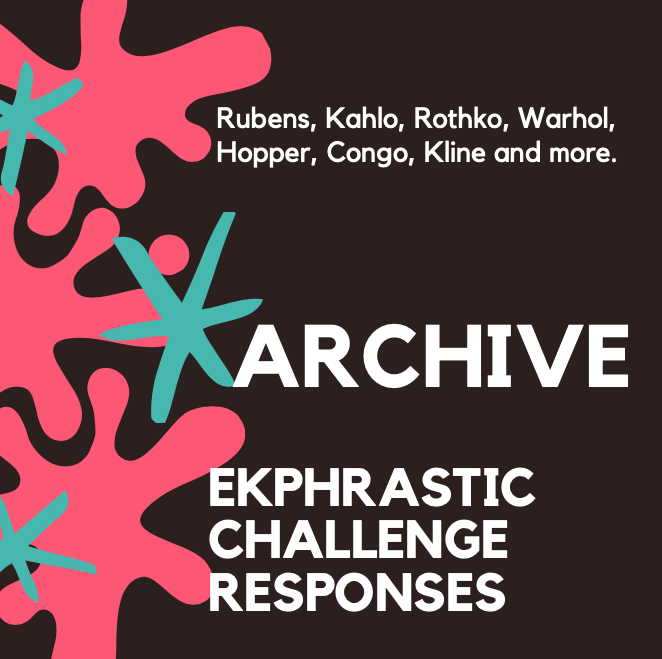|
Paintbrush: a Surgical Tool
The tenuous threads of veins that hold me to myself--to that pulsing lump caught up in my chest--tempt me to cut myself away and watch the white of my dress become vibrant with red. The stain itself my last self-portrait in miniature. Ha! How the Americans would then have something to gawk at. Let me slip from this tumble of bones, these weighty sheets, this broken heap of a self. How Diego would then wrack his huge frame with ugly mourning. Would he stumble into the waiting, outstretched arms of Cristina, my sister, with her rounded cheeks and lush womb? Who could give him everything that I never could? Or maybe he would cast her off as the lump of his own infidelity grew thick in his throat and held him down like a paperweight. Diego. My Frogface. My child, my lover, my universe, my second accident. Diego, who calls me tender. Diego, who calls me acid. Diego, who tears up when Picasso praises me, who is gentle with my scarred skin after the surgeons have finished gashing their way through my body, who tucks me in and then creeps from the room to crawl into the heavy sheets of my sister. I like to peep out from behind the broadness of him, from behind that thick torso and sturdy frame. I like the power of his body in proximity. If I keep him close enough, I can imagine the strength and mobility of his body my own to wield. I slide from this gliding chair and into him. My other self. My other tormentor. I paint myself out of my body. I paint myself whole, fragmented, in a boy’s leather coat and pants like how I used to wear myself when I was young and strong—before the accident. I was going to go into medicine, you know. I was never going to be that gashed thing on the bed. I paint myself in the bright Tehuana dresses with the sweeping skirts that hide my leg. I paint myself swirling storm clouds, and I paint myself Mexico. If I am to be a physical thing, let me be this reviving nation, vivid in the youth if its determination and power and revolt. Let me use myself as a vessel for communicating the full truth of a life. For pain. For loving. Let them know that this scared self has a voice. Sophie Thimmes Sophia Thimmes can often be seen hiking in the woods, munching on vegan carb-based foods, and becoming overly enthused by fat snowflakes falling in her small Utah hometown. She has taught youth theatre, volunteered as an English tutor for children, participated in poetry slams where she has won first prize and performed as an MC, hosted seminars on spoken word poetry, and performed speeches on spoken word poetry at national conferences. She has a thing for stories.
0 Comments
Ben Armstrong
Ben Armstrong is a poet, musician and technical writer from the Black Country, UK. Known for his love of surreal and hyperreal imagery, he often eschews other, more sensible aims to hurtle blindly toward this end. Often times, this has led to a complete lack of interest in his work though he occasionally writes "the hits." He is an alumnus of David Morley’s Warwick Writing Programme and his poems have featured in a number of online journals and zines, the editors of which have superb taste. His first collection of poetry, Perennial, will be released Feb. 2019 (Knives, Forks and Spoons Press). He is currently working on a sequel. Daguerre’s Paris: Boulevard du Temple, Eight O’clock in the Morning*
J'ai capturé la lumière fugitive et l'ai emprisonnée ! J'ai contraint le soleil à peindre des images pour moi.** – Louis-Jacques-Mandé Daguerre What is uncanny about this image is the emptiness of the Paris street, a street that was actually always busy according to everyone who knew it independently of this daguerreotype. But, if the emptiness of the street is surreal, it is still not as strange as the explanation for it. Daguerre’s process took ten to fifteen minutes to fix an image on the silver plate. During that time, only objects that remained perfectly still, like the gentleman getting a shoeshine down in the lower left of the picture, would be photographed. If you were just walking along, shopping for coffee and a newspaper, sweeping water and detritus along in the gutters, or just passing by in your luxurious carriage, you did not register; it was as if you were invisible. Parisian sunup old streets are quiet, empty there’s no place to find coffee or a newspaper but you could get a shoeshine taking a snapshot of sheer silence, palpable hush. If the frock coat getting his shoes shined had sighed we’d have heard him way up here daguerreotypes, like mirrors, show everything backwards your right-handed mother caught with a teacup balanced forever in her left hand Whenever you are up high enough up to see the rooftops of Paris, out of a hotel window or from a friend’s balcony, the main things you notice are the chimney pots. Every building has a row of them (some made of simple red clay, but others are more ornate, made of small mortared stones) corresponding to what once was the number fireplaces in the building. Then city residents woke in those days to the stifling smell of coal smoke hanging in the air and to black soot in their nostrils; now Paris air is polluted by internal combustion engines and the dangerous pall of diesel hangs over the city. when everyone but the shoeshine and his client had fled from the streets did you picture them indoors cowering at their windows? measuring the age dating the present city’s oldest chimney pots they’re not working anymore drifting smoke a memory daguerreotype-- a small sheet of copper or tin where a faint image appeared on a thin silver layer under mercury vapours Our vacation in France was over and we were driving into Paris for a last night in a hotel and a final Parisian supper. We got onto the Périphérique at Paris/Val-de-Marneheading west and north toward our hotel in the 15th Arrondissement. The road was crowded even for a Sunday and the traffic was stop and go. Motorcycles roared past us, coming up between the lines of stopped traffic. “Look!” Jim yelled. “It’s Claude!” Claude was an old but now long-estranged French friend. We were behind him in the traffic and on his right. We could see him in his imported PT Cruiser (“pay-tay-cruz-aire,” he called it), but he didn’t see us. I stayed behind him, watching and knowing he had no idea we were there. When he turned off at the Port-de-Vanvesexit heading for his house in the 14th, we followed, but we went left as he went right. I never saw or heard from Claude again. emptiness is what cannot be seen. The too bright light, the darkness that descends invisibly on ghosts who leave no trace friends who disappear into our memories, changed features dissolving into the subtle gray mists then stripped of all their colours after Monsieur Daguerre painting was forever changed no need to be real pigment and canvas were freed to feel, to know the modern Charles Tarlton Notes *Charles Chevalier, Guide du photographe, Paris, 1854, cit. in Helmut et Alison Gernsheim, L. M. J. Daguerre. The History of the Diorama and the Daguerreotype (1956), New York, Dover, 1968, p. 49. **“I captured the fugitive light and imprisoned it! I forced the sun to paint pictures for me.” https://journals.openedition.org/etudesphotographiques/126 Charles Tarlton: "I am a retired professor who has been writing poetry full time since 2010. I am especially addicted to ekphrasis and have published ekphrastic tanka prose in KYSO Flash, Haibun Today, Atlas Poetic, Contemporary Haibun Online, Review American, Ekphrastic Review, and Fiction International. Next year a collection of my ekphrastic work will be published, entitled Touching Fire." Youth
The symmetry of sunbeams across angular mountains that hypnotic manic stare finger on fourth chakra body proud yoga honed the conceit of youthful talent before Juden war Verboten before the daub of swastikas before the last train out of Prague. Rosalind Adam Rosalind Adam is a Leicester girl, born and bred. She has had three children’s books published, including The Children’s Book of Richard III and her poetry has been published in a number of anthologies. In 2018 she won the G. S. Fraser poetry prize and was awarded a distinction for her MA in Creative Writing at The University of Leicester. Ekphrastic Writing Challenge
Thank you to everyone who participated in our last writing challenge for Saint Joseph with the Infant Jesus, by Guido Reni, which ends today at midnight. Accepted responses for the Guido Reni challenge will be published on January 4, 2019. The prompt this time is Vawdavitch, by Franz Kline. Deadline is January 11, 2019. PLEASE NOTE: In order to better organize submissions, we have a new email for challenge submissions: [email protected] Everyone can participate! Try something new if you've never written from visual art before and discover why there are so many of us devotees. Ekphrastic writing helps artists and lovers of art to look more carefully, from different angles or mindsets, at visual art. And it helps writers discover new ways of approaching their work, their experiences, and writing itself. The rules are simple. The Rules 1. Use this visual art prompt as a springboard for your writing. It can be a poem or short prose (fiction or nonfiction.) You can research the painting or artist and use your discoveries to fuel your writing, or you can let the image alone provoke your imagination. 2. Write as many poems and stories as you like. 3. Have fun. 4. Send only your best results to [email protected]. 5.Include KLINE WRITING CHALLENGE in the subject line in all caps please. Please use this email only for challenge submissions. Continue to use the regular email for regular submissions and correspondence. 6. Include your name and a brief bio. If you do not include your bio, it will not be included with your work, if accepted. Even if you have already written for The Ekphrastic Review or submitted other works and your bio is "on file" you must include it in your challenge submission. Do not send it after acceptance or later; it will not be added to your poem. We are sorry about these technicalities, but have found that following up, requesting, adding, and changing later takes too much time and is very confusing. 7. Late submissions will be discarded. Sorry. 8. Deadline is January 11, 2019. 9. Please do not send revisions, corrections, or changes to your poetry or your biography after the fact. If it's not ready yet, hang on to it until it is. 10. Selected submissions will be published together, with the prompt, one week after the deadline. 11. Rinse and repeat with upcoming ekphrastic writing challenges! NEWS We are very pleased to announce our first guest editor, Bill Waters, who will read and choose submissions for the next, January 11, 2019 challenge. Bill Waters is a New Jersey-based writer whose poetry is everywhere you look. He is best known for short poetry and compressed prose, drawn to creating haiku and other forms of Japanese poetry as well as tiny free verse and flash. He's a longtime contributor to The Ekphrastic Review, having participated in many of the challenges from the start. Bill also runs the Poetry in Public Places Project, a Facebook / real-world group interested in creating and promoting poetry in public spaces to increase the richness of everyday living. He lives in Pennington, New Jersey, U.S.A., with his wonderful wife and their two amazing cats. Visit him at https://billwatershaiku.wordpress.com/. We are going to have occasional special guest editors judging some challenges in the year ahead! We're hoping this will inspire us in unexpected ways, add new flavours and perspectives to the journal, foster community, and widen readership. When a challenge has a guest editor, it will be announced in advance as well as in this space the day the prompt is posted. We're excited about this and about having a whole year of challenges, now that we've found an ekphrastic prompt system that is working in terms of consistency and longevity. Many great poems will be written in the year ahead! Ceremonial Ghosts, Snacking on Corpuscles Ceremonial ghosts, snacking on corpuscles, wear red capes to the funeral. Clambering into the parlour, they do not keep their distance from the deceased, to whom they whisper, “Let’s go!” Obeying, the departed bubbles up through ceiling and clouds to join his brethren ghosts on to another wake. Back on earth, those who weep goodbyes, and still believe in the freedom of time, head for cars and drive into the maw of the nation, their dispersal but a passing mirage. Hungry Ghosts Snake Hungry ghosts snake their way through food lines, but worms have devoured apples, oranges, pears. Some folks say death is a return to innocence; others say it is better not to bear existence anymore because the cries of swallowed flesh should not have to be heard. But no one can silence mortal wounds, nor are they the final call. Ask ghosts—they will tell you those victorious worms are soon to be pecked at by beaks that will spirit them off to baby robins. Rapacious Ghosts Have Covered Rapacious ghosts have covered their faces and bodies with cobalt and teal cloth stolen from icons they foolishly mocked without a trace of irony. They cannot access their souls that have long ago flown away, dispirited, not caring how far from divinity they have strayed. In brown midnight, their entrance into the brotherhood of sisters and sisterhood of brothers is veiled. Sprigs of yellow hope spring up from below, but it is too late for joy. Greedy for love, they succumbed to hate. Uncle Y Follows Aunt B Uncle Y follows Aunt B into the crowd through the green haze, looking for her eyes, but everyone is blue, and their features have melted away. He is swept aside; he cannot feel how once she held him softly, nor remember on which street she said she would wait. Not having found her, he has grown fond of strangers who pine for what used to be. Ghosts Do Not Mirror Exactly
Ghosts do not mirror exactly who you think you are when you pose before them. They project their own take on your idea of yourself, taunting unto infinity the foolishness you have passed off as sapience. They reckon your blue logic as spent passion, watching you lose balance in the red hot waters of lust they gauge to be ice. Mark Melnicove These poems and paintings are from the book Ghosts, published by the author and artist, December 2018. Mark Melnicove is author of a 2017 limited edition collaboration (Sometimes Times) with artist Terry Winters, published by Two Palms Press, NYC; Africa is Not a Country, published by the Lerner Publishing Group; and the 1984 bestseller, The Uncensored Guide to Maine. He lives in Dresden, Maine. Considered one of the best artists working in Maine, Abby Shahn has work in many collections including the Portland Museum of Art, Colby College Museum of Art, Bowdoin College Museum of Art, and the Farnsworth Art Museum. Her first exhibit was at City Lights Books, San Francisco, in 1960. She lives in S. Solon, Maine. Silence
Caught at last in this brown caution, this wake of sound beyond the known alphabet, where is our refuge? Frame of forgetting. Frame of remembering. Floor of a faith forever gone. Steps we’ve taken, those footprints are in us forever. Listen. All those words we never will say, echoing. Ingrid Wendt This poem was first published in Ingrid Wendt's book, Evensong (Truman State University Press, 2011) Ingrid Wendt’s first book, Moving the House, was selected by William Stafford for the New Poets of American Series, published by BOA Editions (1980). Her next three books received the Oregon Book Award (1987), the Yellowglen Award and the Editions prize from WordTech Editions (2003 and 2004). She is co-editor of the anthology In Her Own Image: Women Working in the Arts (1980) and the Oregon poetry anthology From Here We Speak (1993). Her most recent book, Evensong, is available from Truman State University Press (2011). She has taught poetry writing for over thirty years, at all educational levels, most recently as a Fulbright Senior Specialist at the University of Freiburg, Germany. She lives in Eugene, Oregon. www.ingridwendt.com Still Life with Skull, 1850
Not dancing, dangling-- stillborn bones stand still in a bell jar. The hourglass has been flipped, and I’ll cry over spilt sand. It’s endless what I can cry about: lust, thirst, thorns, debt, and death, of course. I won’t cry when I’m dead; a skull has no eyes to wipe dry. Little Jesus still dead on the cross is thin as a minnow. A miracle is every day I am still alive. Matthew Murrey Matthew Murrey: "My poems have appeared in many journals such as Prairie Schooner, Poetry East, and Rattle. I received an NEA Fellowship in Poetry a number of years ago, and my first book manuscript, Bulletproof, will be published soon by Jacar Press. I am a high school librarian in Urbana, Illinois where I live with my partner. We have two adult sons. My website is at https://www.matthewmurrey.net/" Hopper's Women
are always alone, even if someone else is in the room, even if they’re leaning at the counter of an all-night diner. This woman is standing in the open mouth of her doorway as if it were the prow of an ocean liner, ready to embark on a long voyage. Her dress and lips part in anticipation. The sun pounds down, a relentless spotlight, but she is unblinking in its glare, stares off in the middle distance. Triangular shadows slice the air; rough waters ahead. The curtain of the sky rises. Everything is about to begin. Barbara Crooker This poem first appeared in Barbara Crooker's book, More (C&R Press). Barbara Crooker is the author of nine books of poetry; Les Fauves is the most recent. Her work has appeared in many anthologies, including The Bedford Introduction to Literature, Commonwealth: Contemporary Poets on Pennsylvania, The Poetry of Presence and Nasty Women: An Unapologetic Anthology of Subversive Verse. www.barbaracrooker.com Pietà When Zephyr combs a field of wheat it’s the wheat in motion we remember, not the ancient name for the wind. To stand before the Pietà is to see through theology to an intense actuality in marble. Picture books can’t prepare us for the real thing. The dead son is draped across his mother’s lap. Her outstretched left hand, palm up in heavenly supplication, articulates a grief only a mother can know. Meanwhile, her right hand helps hold him up. If she rose she would stand seven feet, a grief taller than her son. And she appears younger than he. Hers is an ageless grief that stars the basilica’s gloaming with an arctic solitude that never ceases to draw a crowd. Even if we didn’t already know, this is what we have traveled to find: a work of human hands that cracks open some unknown door, delivering us, for a few moments anyway, into a realm where we are no longer tourists on earth. Mike Dillon This poem previously appeared in Mike Dillon's book, Coracle, Bellowing Ark Press, 2011. Mike Dillon lives in Indianola, Washington, a small town on Puget Sound northwest of Seattle. He is the author of four books of poetry and three books of haiku. Several of his haiku were included in "Haiku in English: The First Hundred Years," from W.W. Norton (2013). “Departures,” a book of poetry and prose about the forced removal of Bainbridge Island’s Japanese Americans after Pearl Harbor will be published by Unsolicited Press in April 2019. |
The Ekphrastic Review
COOKIES/PRIVACY
This site uses cookies to deliver your best navigation experience this time and next. Continuing here means you consent to cookies. Thank you. Join us on Facebook:
July 2024
|
